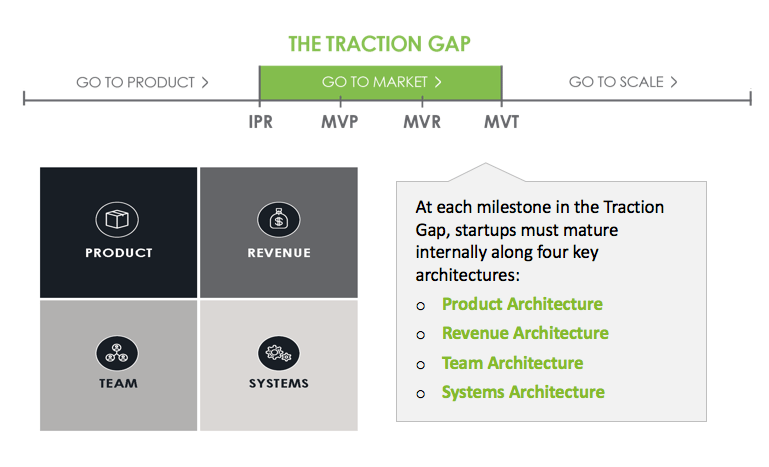Building a foundation for crossing the Traction Gap
September 19, 2016
PUBLISHED BY Bruce Cleveland
SOURCE PeHub
To successfully scale as a company and to help ensure future rounds of financing, startups must understand the framework of the Traction Gap and abide by the four rules of thumb. As I discussed in two previous columns last month, companies must define their initial product release, identify their minimum viable product, quantify their minimum viable repeatability and finally drive to minimum viable traction.
But, before they can follow these rules, startups need to understand the underlying foundation, or core architectures, that must be in place to develop traction.
The biggest impediments to securing the next round of financing are an incomplete product, team, revenue line or systems architecture.
Product architecture
A startup’s product architecture includes the set of technologies, applications and features that comprise its offerings. A well thought out product architecture enables startups to achieve rapid product/market fit through customer validation.
Occasionally, in spite of early product acceptance, a team may discover it needs to pivot its product, change the product positioning or add significant capabilities in order to secure sustainable fit in a viable market category. Teams must have the patience to postpone expensive go-to-market scaling until such a fit has been confirmed.
Of the four elements critical to minimum viable repeatability, the product architecture is where early stage startups tend to have the most well-developed plans and expertise.
Revenue architecture
A startup’s revenue architecture is defined by its business model and its ability to monetize awareness, engagement and sustained usage. When a startup reaches a minimum viable product, it may still be experimenting with business models and processes that convert interest into revenue.
For B2C (or B2B2C) startups, this normally translates into testing techniques that optimize lifetime value to customer- acquisition-cost ratios, along with increasing engagement of monthly active users. For B2B, revenue architecture involves strategies to lower customer acquisition costs, identify up-sell opportunities, increase usage rates and optimize conversion rates.
Scaling prior to reaching minimum viable repeatability can be disastrous for a startup and its investors. The result is often a material down round, layoffs, significant employee ownership dilution and even shutdown.
Team architecture
Early-stage startups often have small product-oriented teams and have not yet hired a complete management team or the other personnel they need to scale the company. Many times, the wrong people are hired for the wrong role, or early team members are unable to scale with the startup. Other times, the founding team may pull together a good core management team, but then lack a comprehensive strategy to address the extended team. Getting the team architecture right is key to reaching minimum viable repeatability on the path to minimum viable traction.
Systems architecture
The systems and processes of a startup can either help it accelerate growth or hold it back. These must integrate front and back offces, establish transparent performance metrics and cultivate the progressive cultures needed to succeed.
Many early-stage startups use QuickBooks for accounting, a simplistic CRM implementation for sales and support, and a simple e-commerce platform for the web. By the time they reach minimum viable traction, they need to be on sophisticated platforms using much more refined business processes.
In addition to operational systems, startups must ensure they have a well-designed development stack. Very real make-or- break choices are often made with respect to the engineering management infrastructure that can negatively impact margins and prevent the company from scaling later on.
We believe that once a startup has demonstrated mastery over these four areas, acquired a meaningful cohort of customers using its now proven go-to-market strategy and executed several quarters of successive growth, it is prepared to declare minimum viable traction.
Financing rounds are a poor proxy for company maturity
The startup community — entrepreneurs, boards and investors — will be far better served if it stops describing early-stage companies in terms of their financing round series. Instead, it needs to change its focus to the company’s maturity using the Traction Gap framework for measuring the company’s development and its ability to build the proper foundation for its success.
The new focus should be on where these companies are in terms of the Traction Gap and the strategies and tactics they can use to reach each value inflection point. Steve Blank, an author, Stanford professor and successful entrepreneur agrees, noting that “the Startup Owners Manual and the Lean Launchpad class were developed to help entrepreneurs go from an idea to a product that customers want. The Traction Gap is a much-needed framework for the next step in that progression, taking a minimally viable product and growing it to sales repeatability and traction.”
By following a few simple rules, and optimizing the four core architectures, companies can traverse the gap quickly and use capital more effciently. This shift in thinking is necessary for those companies that wish to succeed in the increasingly discerning capital environment that may lie ahead.
Read the original article in Venture Capital Journal here.
Editor’s Note: Bruce Cleveland discussed the Traction Gap in a pair of columns in August. This is his third article on the topic. The other two are “Understanding the Traction Gap” and “How to bridge the Traction Gap.”
Photo courtesy of iStock.com/Leontura
KEYWORDS